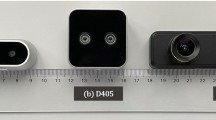Zusammenfassung
To support minimally-invasive intraoperative mitral valve repair, quantitative measurements from the valve can be obtained using an infra-red tracked stylus. It is desirable to view such manually measured points together with the endoscopic image for further assistance. Therefore, hand-eye calibration is required that links both coordinate systems and is a prerequisite to project the points onto the image plane. A complementary approach to this is to use a vision-based endoscopic stereo-setup to detect and triangulate points of interest, to obtain the 3D coordinates. In this paper, we aim to compare both approaches on a rigid phantom and two patient-individual silicone replica which resemble the intraoperative scenario. The preliminary results indicate that 3D landmark estimation, either labeled manually or through partly automated detection with a deep learning approach, provides more accurate triangulated depth measurements when performed with a tailored image-based method than with stylus measurements.
Access this chapter
Tax calculation will be finalised at checkout
Purchases are for personal use only
Preview
Unable to display preview. Download preview PDF.
Similar content being viewed by others
Literatur
Casselman Filip P., Van Slycke Sam, Wellens Francis, De Geest Raphael, Degrieck Ivan, Van Praet Frank et al. Mitral valve surgery can now routinely be performed endoscopically. Circulation. 2003;108:II–48.
Boone N, Moore J, Ginty OK, Bainbridge D, Eskandari M, Peters TM. A dynamic mitral valve simulator for surgical training and patient specific preoperative planning. SPIE, 2019.
Engelhardt S, Sauerzapf S, Preim B, Karck M, Wolf I, De Simone R. Flexible and comprehensive patient-specific mitral valve silicone models with chordae tendinae made from 3D-printable molds. Int J Comput Assist Radiol Surg. 2019;14(7):1177–86.
Engelhardt S, De Simone R, Al-Maisary S, Kolb S, Karck M, Meinzer HP et al. Accuracy evaluation of a mitral valve surgery assistance system based on optical tracking. Int J Comput Assist Radiol Surg. 2016;11(10):1891–904.
Engelhardt S, Wolf I, Al-Maisary S, Schmidt H, Meinzer H, Karck M et al. Intraoperative quantitative mitral valve analysis using optical tracking technology. Ann Thorac Surg. 2016;5:1950–6.
Engelhardt S, De Simone R, Zimmermann N, Al-Maisary S, Nabers D, Karck M et al. Augmented reality-enhanced endoscopic images for annuloplasty ring sizing. Augmented Environments for Computer-Assisted Interventions. Springer International Publishing, 2014:128–37.
Sharan L, Romano G, Brand J, Kelm H, Karck M, De Simone R et al. Point detection through multi-instance deep heatmap regression for sutures in endoscopy. Int J Comput Assist Radiol Surg. 2021.
Lepetit V, Moreno-Noguer F, Fua P. EPnP: an accurate O(n) solution to the PnP problem. Int J Comput Vis. 2009;81(2):155.
Ronneberger O, Fischer P, Brox T. U-Net: convolutional networks for biomedical image segmentation. MICCAI 2015. Springer International Publishing.
Author information
Authors and Affiliations
Corresponding author
Editor information
Editors and Affiliations
Rights and permissions
Copyright information
© 2022 Der/die Autor(en), exklusiv lizenziert an Springer Fachmedien Wiesbaden GmbH, ein Teil von Springer Nature
About this paper
Cite this paper
Burger, L. et al. (2022). Comparison of Depth Estimation Setups from Stereo Endoscopy and Optical Tracking for Point Measurements. In: Maier-Hein, K., Deserno, T.M., Handels, H., Maier, A., Palm, C., Tolxdorff, T. (eds) Bildverarbeitung für die Medizin 2022. Informatik aktuell. Springer Vieweg, Wiesbaden. https://doi.org/10.1007/978-3-658-36932-3_35
Download citation
DOI: https://doi.org/10.1007/978-3-658-36932-3_35
Published:
Publisher Name: Springer Vieweg, Wiesbaden
Print ISBN: 978-3-658-36931-6
Online ISBN: 978-3-658-36932-3
eBook Packages: Computer Science and Engineering (German Language)




